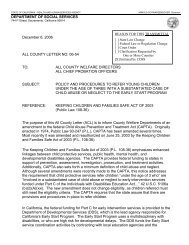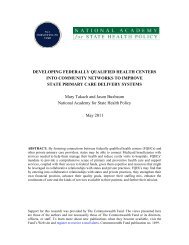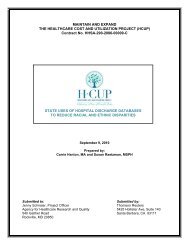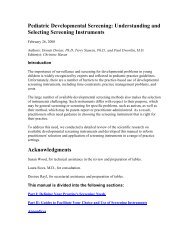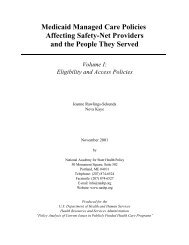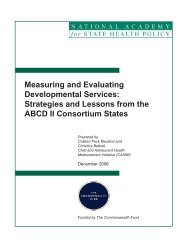Improving Care Coordination, Case Management, and Linkages to
Improving Care Coordination, Case Management, and Linkages to
Improving Care Coordination, Case Management, and Linkages to
Create successful ePaper yourself
Turn your PDF publications into a flip-book with our unique Google optimized e-Paper software.
2<br />
Executive Summary<br />
As pediatric primary health care providers increase appropriate developmental screening <strong>and</strong> early<br />
identification of developmental delays in young children, the weak linkages among providers of<br />
services <strong>to</strong> children <strong>and</strong> families become increasingly apparent. Young children often fall through<br />
the cracks between pediatric primary health care providers <strong>and</strong> providers of mental health, early intervention,<br />
child welfare, <strong>and</strong> early care <strong>and</strong> education services.<br />
Currently, there is a call for better linkages that support families in securing appropriate care <strong>and</strong> services.<br />
Five major types of barriers limit these linkages:<br />
•<br />
•<br />
•<br />
•<br />
•<br />
Constraints on primary care provider capacity <strong>to</strong> refer <strong>to</strong> <strong>and</strong> link <strong>to</strong> other community resources;<br />
Inadequate service capacity for early childhood developmental <strong>and</strong> mental health services;<br />
Gaps between programs <strong>and</strong> service delivery systems, including eligibility criteria;<br />
Insufficient payment/financing for time spent in referral <strong>and</strong> coordination efforts; <strong>and</strong><br />
Different practice cultures <strong>and</strong> cus<strong>to</strong>ms.<br />
States can play an important role in removing barriers <strong>and</strong> providing support as communities move <strong>to</strong>ward<br />
more integrated services. Federal programs can support state efforts <strong>to</strong> improve linkages. Medicaid,<br />
through its Early Periodic Screening, Diagnosis, <strong>and</strong> Treatment (EPSDT) program; Children’s Health Insurance<br />
Programs (CHIP); Title V Maternal <strong>and</strong> Child Health <strong>and</strong> Children with Special Health <strong>Care</strong> Needs<br />
programs; <strong>and</strong> programs implemented under the Individuals with Disabilities Act (IDEA), especially Part C<br />
Early Intervention Programs, provide a way <strong>to</strong> finance care coordination/case management (CC/CM) for<br />
health <strong>and</strong> related services.<br />
Strategies <strong>to</strong> improve CC/CM <strong>and</strong> strengthen linkages include primary care practice-based strategies,<br />
service provider linkage strategies, <strong>and</strong> systems change <strong>and</strong> cross-system strategies. This report uses a<br />
framework that illustrates the intersection between these three levels <strong>and</strong> the various roles states can play<br />
<strong>to</strong> facilitate <strong>and</strong> support CC/CM <strong>and</strong> linkages as illustrated in Table 1.<br />
States can review existing policies of key programs <strong>to</strong> identify barriers <strong>and</strong> opportunities for improvement.<br />
In particular, review of case management/care coordination rules <strong>and</strong> payments is critical. This paper<br />
provides key questions for reviewing state policies <strong>and</strong> financing strategies that support cross-system linkages<br />
<strong>and</strong> care coordination/case management (C/CM). Areas for action within each of the state’s fiscal<br />
<strong>and</strong> administrative support roles are provided.<br />
<strong>Improving</strong> <strong>Care</strong> <strong>Coordination</strong>, <strong>Case</strong> <strong>Management</strong>, <strong>and</strong> <strong>Linkages</strong> <strong>to</strong> Service for Young Children: Opportunities for States<br />
National Academy for State Health Policy



